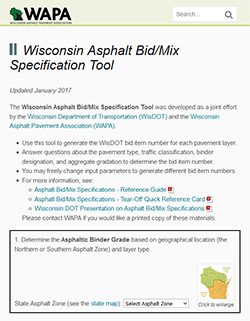
In this Executive Update we highlight Wisconsin and national meetings as well as revisions to Wisconsin’s combined bid tool.
- Sharing Tools with Wisconsin Towns
- NAPA Annual Meeting Highlights
- Seen and Heard at TRB
- Update: Wisconsin Bid-Mix Specification Tool
WAPA has been busy this winter with outreach to Wisconsin towns. In late January, we provided an overview on asphalt pavement to 40 people representing upwards of 30 towns. The event was held in Ruby and hosted by the Chippewa County Unit.
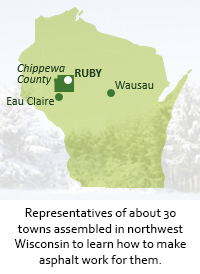 The meeting kicked off with a presentation from our Engineering Director Deb Schwerman about the different tools available for asphalt pavements, from mix design and construction to rehabilitation and preservation. “We covered our design guide, the PASER rating system, the latest bid-mix specification tool — just about everything anyone wanted to talk about,” Schwerman says.
The meeting kicked off with a presentation from our Engineering Director Deb Schwerman about the different tools available for asphalt pavements, from mix design and construction to rehabilitation and preservation. “We covered our design guide, the PASER rating system, the latest bid-mix specification tool — just about everything anyone wanted to talk about,” Schwerman says.
We stressed to the audience how WAPA and its members are eager to continue building partnerships with Wisconsin municipalities, counties and consultants to put the right tools in their hands and provide ongoing support for asphalt pavements.
“I also was pleased by the lengthy Q-and-A that followed,” Schwerman says. “The town representatives in the room were highly engaged and definitely wanted to know more about challenges and solutions when it comes to asphalt pavements.”
This is just one example of the numerous educational training sessions WAPA offers to our membership. We welcome the opportunity to present to others who may be interested in hearing a similar presentation and holding follow-up discussions. Please let us know how we can bring this message to you.
In late January we attended the National Asphalt Pavement Association (NAPA) Annual Meeting, an outstanding opportunity as always to collaborate on a national level to help advance all aspects of asphalt pavements.
Strategic Coordination
I had very productive meetings with NAPA’s marketing, policy and advocacy committees and task groups, including Pavement Economics, Political Action, Legislative, and Communications. Given new executive leadership and priorities in the federal government, it was vital for us to share knowledge and contribute ideas toward building national strategies.
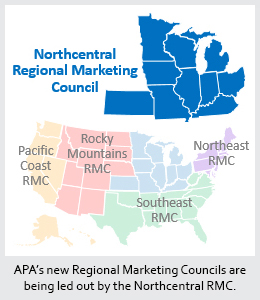 The meeting was also a forum for the Asphalt Pavement Alliance (APA) to showcase its Regional Marketing Councils (RMCs) and convene our regional group, the Northcentral RMC. The Northcentral RMC includes Wisconsin along with nine nearby states and is headed by Dan Staebell, who previously gave an Overview Presentation about this effort at the 2016 WAPA conference.
The meeting was also a forum for the Asphalt Pavement Alliance (APA) to showcase its Regional Marketing Councils (RMCs) and convene our regional group, the Northcentral RMC. The Northcentral RMC includes Wisconsin along with nine nearby states and is headed by Dan Staebell, who previously gave an Overview Presentation about this effort at the 2016 WAPA conference.
The North Central RMC will be addressing four initiatives that are high priorities across the 10 states: life cycle cost analysis, rehabilitation, design thickness, and strategic marketing. To this end, Staebell will work in close cooperation with the Asphalt Institute (AI), NAPA, WAPA, other state asphalt pavement associations, and asphalt producers and suppliers.
Technical Highlights
Deb was actively engaged with committees that are advancing innovative asphalt technologies. She’s a member of the Committee for Asphalt Research and Technology (CART) and attended several other committee meetings as well. Technical highlights include the following:
- Collaborative work with FHWA has resulted in the highly-anticipated NAPA Special Report 213: Use of RAP & RAS in High Binder Replacement Asphalt Mixtures: A Synthesis as well as a companion FHWA TechBrief, available soon. The research focuses on the benefits of using RAP and RAS in asphalt pavement construction operations, including economic, conservation, energy, and emissions factors.
- NAPA’s draft national guidelines on the use of Thinlays for pavement preservation are also nearing completion, with the final report expected soon. This will address proper project selection, best practices for design and construction, Thinlay performance, and benefits of Thinlays compared with other preservation treatments.
- From the Environmental Sustainability Task Group, the new Emerald Eco-Label branding for NAPA-verified environmental product declarations (EPD) generated a lot of excitement. To promote the program, brochures, a video, print advertisements, media outreach, and webinars are being developed for release in 2017.
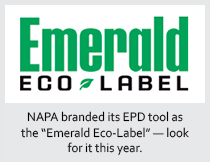
NAPA’s comprehensive research efforts are compiled in its January 2017 Research Project Summary.
Northeast Asphalt Wins National Award
We are tremendously proud that one of WAPA’s own, Northeast Asphalt, was honored at the NAPA annual meeting with the 2016 Sheldon G. Hayes Award for excellence in the construction of an asphalt pavement. Read our Press Release for full details about Northeast Asphalt’s innovative work with WisDOT in constructing State Trunk Highway 26 from Waupun to Rosedale.
The award, the second for Northeast Asphalt, is a pinnacle achievement, and it showcases how Wisconsin has some of the very best asphalt contractors in the United States. Congratulations to all those involved who helped bring the award home to Wisconsin.
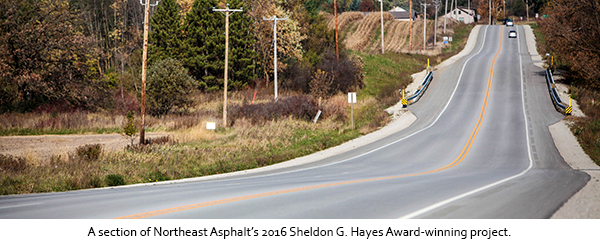
Deb Schwerman also attended the Transportation Research Board Annual Meeting this January with an eye on what’s happening in asphalt research and innovation and what it means for Wisconsin. She reported on three eye-openers of the event:
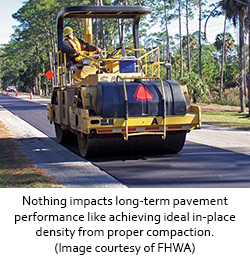 Brandon Strand and I have discussed in-place density in the Executive Updates throughout 2016 and at every meeting we go to, so it should come as no surprise that compaction was a big topic at TRB this year. This was the focus of Session 381, Impact of Compaction on Asphalt Pavement Performance, where the in-place density was stressed as “one of the most important factors that influence the performance of an asphalt pavement leading to long term serviceability.” Conservatively, a 1 percent increase in in-place density can lead to a 10 percent increase in service life. Wisconsin was front and center at this session, with perspectives from both industry (Erv Dukatz with Mathy Construction) and government (WisDOT’s Barry Paye).
Brandon Strand and I have discussed in-place density in the Executive Updates throughout 2016 and at every meeting we go to, so it should come as no surprise that compaction was a big topic at TRB this year. This was the focus of Session 381, Impact of Compaction on Asphalt Pavement Performance, where the in-place density was stressed as “one of the most important factors that influence the performance of an asphalt pavement leading to long term serviceability.” Conservatively, a 1 percent increase in in-place density can lead to a 10 percent increase in service life. Wisconsin was front and center at this session, with perspectives from both industry (Erv Dukatz with Mathy Construction) and government (WisDOT’s Barry Paye).
Session 307, Black Space Is Not a Black Hole: Past, Present, and Future of Asphalt Binder Rheological Parameters, provided a detailed look into binder characterization. The session featured a presentation about field experience with binder rheological parameters as presented by Andrew Hanz with MTE, a division of Mathy. Another presenter at this session was Geoffrey Rowe of Abatech who explored the black space characterization of binders. You may recall that Rowe gave a Technical Presentation on Asphalt Modification at the 2016 WAPA conference.
Beyond the technical sessions, I was struck by the number of exhibitors who displayed maintenance and preservation solutions. There’s a growing consensus that we need to preserve existing roadways to get the maximum useful life out of them, and vendors at the TRB Meeting were eager to share a wide range of tools to help pavement owners get the most bang for their buck in light of funding and budgetary uncertainties.
Thanks to all the positive feedback we have received on the Wisconsin Asphalt Bid/Mix Specification Tool that WAPA developed in partnership with WisDOT. We’re happy to report a few minor system updates designed to make the interactive tool even more useful:
- We incorporated two new WisDOT bid item numbers. These allow for heavy modification of upper layers (new pavements and overlays) where low traffic volumes are anticipated.
- We streamlined the options across the board to exclude some mixes that are not recommended, such as very small aggregate gradations used for lower layers and very large aggregate gradations used for upper layers.
- We updated the WisDOT thickness guidance. In addition to a reference and link to the 2017 Standard Specifications Section 460, Paragraph 460.3.2, “Thickness,” for thickness by layer type, the tool also notes the current minimum layer thicknesses.
These are minor changes, but we feel that this tool is only valuable if it is current and provides the most practical guidance possible. We will continue to work closely with WisDOT and make additional revisions whenever they become necessary.
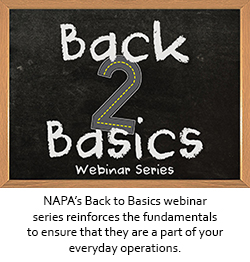 The winter is always a whirlwind of meetings, but warmer weather and the paving season will be upon us soon enough.
The winter is always a whirlwind of meetings, but warmer weather and the paving season will be upon us soon enough.
With that in mind, be sure to check out NAPA’s new Back to Basics webinar series, designed to help you or your employees brush up on the fundamentals for producing quality asphalt pavements. As the industry continues to advance both in technology and mix design methods, these are standard principles that remain the same and should not be forgotten.
As always, please don’t hesitate to contact us if you have any questions or if there is ever any way we may be of assistance. That’s it for now. Thanks and stay in touch.





